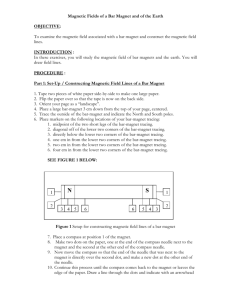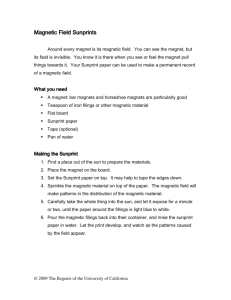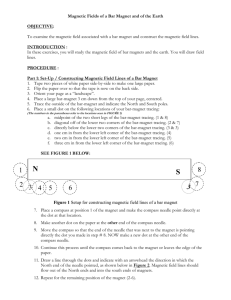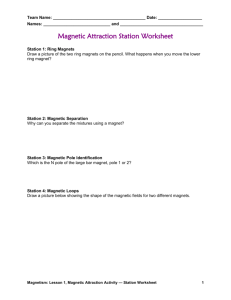10.3.1 Grade 5 Standard 3 Unit Test A Magnetism Multiple Choice 1
advertisement
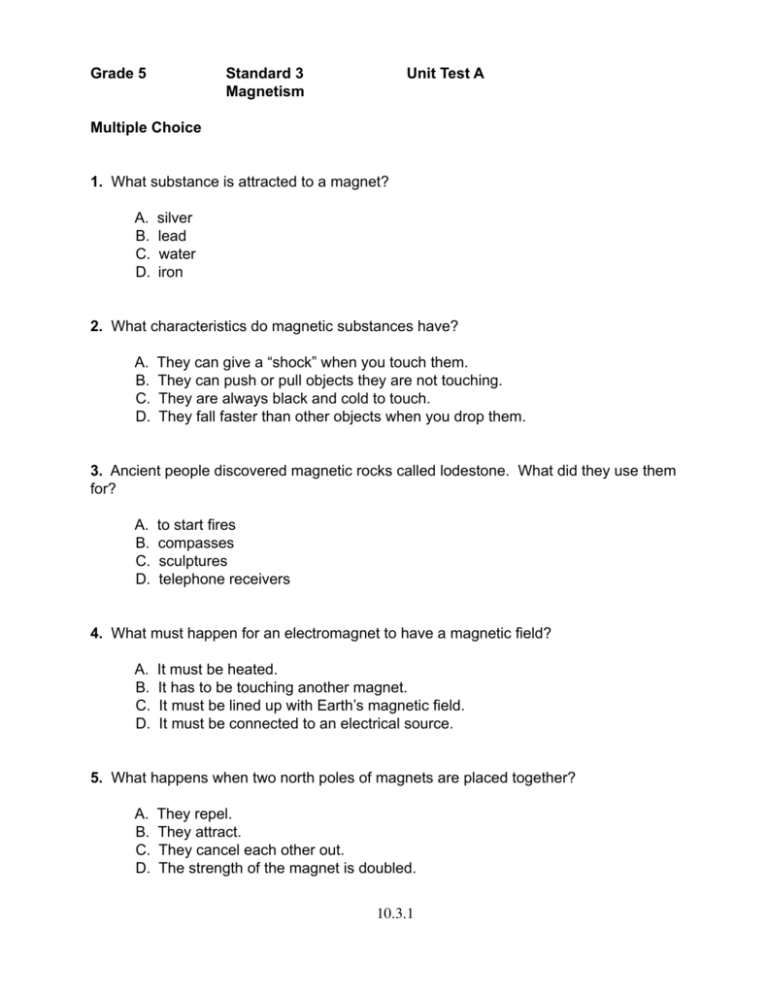
Grade 5 Standard 3 Magnetism Unit Test A Multiple Choice 1. What substance is attracted to a magnet? A. B. C. D. silver lead water iron 2. What characteristics do magnetic substances have? A. B. C. D. They can give a “shock” when you touch them. They can push or pull objects they are not touching. They are always black and cold to touch. They fall faster than other objects when you drop them. 3. Ancient people discovered magnetic rocks called lodestone. What did they use them for? A. B. C. D. to start fires compasses sculptures telephone receivers 4. What must happen for an electromagnet to have a magnetic field? A. B. C. D. It must be heated. It has to be touching another magnet. It must be lined up with Earth’s magnetic field. It must be connected to an electrical source. 5. What happens when two north poles of magnets are placed together? A. B. C. D. They repel. They attract. They cancel each other out. The strength of the magnet is doubled. 10.3.1 6. How is Earth’s magnetic field similar to that of a magnet? A. B. C. D. It has North and South poles. It is hundreds of miles long. It is made in Earth’s core. It is shaped like a horseshoe. 7. What is our best evidence that Earth has a magnetic field? A. B. C. D. All things fall toward Earth’s center. A compass needle lines up with it. Winds blow from east to west. Earth’s oceans all have currents. 8. Which of these drawings correctly shows the shape of Earth’s magnetic field? N N N B. C. A. 9. Which of the following shows the correct shape of a bar magnet’s magnetic field? A. B. C. 10. Earth’s magnetic field and a bar magnet both attract particles to the same locations. Where are they? A. B. C. D. the middle all around the outside the North and South poles first to the middle, then to the ends 10.3.2 Constructed Response 1. Why does a compass needle point North? 2. How could you find out if magnets worked to relieved a persons’ pain? 3. Describe the steps you would take to make a simple working compass. 4. What do the magnetic fields of a bar magnet, horseshoe magnet and disc magnet have in common? 10.3.3 Answers Standard 3 Unit Test: Multiple Choice 1. D 2. B 3. B 4. D 5. A 6. A 7. B 8. A 9. A 10. C Constructed Response 1. It is attracted to Earth’s magnetic pole. 2. Give some people magnets to place on painful areas, and give other people non-magnetic replicas. See who thinks their pain goes away. 3. I would take a cup of water and a slender needle that has been magnetized by a strong magnet. I would place the needle through a small piece of cork so that it would float on the surface of the water. I would figure out which direction was North by looking at the sun or the North star. The opposite direction would be South. East would be to my right and West to my left. 4. The lines of force all curve from the North pole to the South pole. 10.3.4 Grade 5 Standard 3 Magnetism Performance Test 1 Title: Using Magnets Activity Description Students will design a series of experiments to explain how magnets work. Materials 2 magnets per student group, assorted objects (paper clips, wood blocks or match sticks with heads removed, plastic Legos, wire, aluminum foil, marbles etc.) rulers, anything else students may request that you can easily get. Student sheet (p. 10.3.6) may be used or students can write on their own paper. Time Needed 40 to 60 minutes Procedure 1. Explain to students that they will be working in groups and designing an experiment based on magnets. 2. Show students the materials they have to work with and have them write a hypothesis like: If I test different substances, then some will be attracted to the magnet and some will not. Or: If I put two magnets together, then they will be twice as strong as one. Or: If I place magnets together and they attract, then I can place a substance in between them and they will not attract. Or: If I test the distance a magnet can attract a paper clip, then it will be the same for the North and South poles. 3. Have students write their hypothesis on the board and make sure they are not all doing the same one. If two groups are the same, have one think of something different. 4. Once they have decided on a hypothesis, give students some time to write their procedures for finding the answer to their hypothesis. You may wish to check these also. 5. Students should work with the materials and write down their findings in data. 6. When students are done, each group should report to the class what they found. Scoring Guide 1. Students write a correctly written hypothesis……………………….5pts 2. Students write a procedure………………………………………… 5 pts 3. Students collect and record data……………………………………10 pts 4. Students present data to class and explain………………………...5 pts 10.3.5 Student Sheet Name__________________ Title: Using Magnets Introduction: In this activity you will plan an investigation to learn about magnets. You can use the materials your teacher has provided, or think of some other materials that must be available. Try to think of a question about magnets and develop a hypothesis to start answering it. A hypothesis is written like this: If (I do something) then, (what do I think will happen?) Remember to be creative and think of as many things as you can. Talk with your group and decide on just one. After you write your hypothesis, plan a set of steps (procedures) to find out the answer. Write them down also. Then do the experiment and write down what happens (data). Have fun! Hypothesis: Procedure: 1. 2. 3. 4. 5. Data: Conclusion: (What did you learn about your hypothesis?) 10.3.6 Grade 5 Standard 3 Magnetism Performance Test 2 Title: Which is stronger? Activity Description Students will determine the comparative strengths of Earth’s magnetic field with that of a bar magnet. Materials Bar magnet, compass, meter stick per group Time Needed 30 minutes Procedure 1. Students should work in groups of 3 or 4. 2. Ask students to determine the maximum distance their magnet will have an effect on the compass. 3. Make sure students start with compasses lined up to North Pole. Have them try holding the magnet near the compass. Rotate the compass and watch what happens. 4. Once students learn how to “distract” the compass, have them see how far from the compass they can move the magnet and still have an effect on the compass. They should measure the distance in meters or centimeters. 5. Have students answer the questions written on the student sheet. 6. Students should compare answers. Their results will vary based on the strength of the magnet they received. Scoring Guide 1. Students determine distances ………………………………………..5 pts 2. Students answer questions correctly……………..…………............5 pts 10.3.7 Student Page Name_________________ Which is Stronger? Directions: 1. Line your compass up so that the N is at the point of the needle. Check with your teacher to make sure you have done it correctly. 2. Place the magnet under the compass and rotate the magnet. Notice what happens. 3. With your compass needle “distracted” to the wrong place start to move the magnet away from the compass. 4. As soon as the needle goes back to North, stop and measure the distance with the meter stick. Write your answer in centimeters. Distance: Questions: 1. Why does the compass needle normally point North? 2. Why does the magnet change the compass? 3. Which is stronger, Earth’s magnetic field or the compass’s field? 4. What happens to the strength of a magnetic field as you move farther from it? 5. Did all the groups in your class get the same answer? Why or why not? 10.3.8 Grade 5 Standard 3 Magnetism Performance Test 3 Treasure Hunt Activity Description Students will take a compass and simple map of the school and use it to find an object. Materials Needed Simple compasses, a map of school with North clearly labeled. A direction sheet showing how many steps, and in what direction, the students will take to find the “treasure.” The teacher will have to prepare this in advance. The “treasure” can be any item. Time Needed: Teacher preparation of the map, about 1/2 an hour Student work: about an hour Procedure 1. Acquaint students with the use of the compasses and map. 2. Describe the method of pacing off distances. If you prefer to have the distances measured, provide meter sticks. 3. Tell students to trace their paths on the map as they go. 4. Allow students to work in groups; one group going at a time. Leave the treasure so that other groups can find it. (If the treasure is candy, each group could have some. A parent volunteer might be helpful to prevent piracy.) 5. Students should fill out the worksheet. Scoring Guide 1. Students find and describe the “treasure” ........................................10 pts 2. Students participate and behave properly...........................................5 pts 3. Students correctly fill out and answer questions on worksheet.........10 pts 10.3.9 Student Worksheet Name_________________ 1. Draw your compass. 2. What happens when you rotate the compass? 3. Where must the compass be pointing to use it on the map? 4. What must the map have to be useful with a compass? 5. What was the treasure? 6. On your map, trace the path you took. 10.3.10

